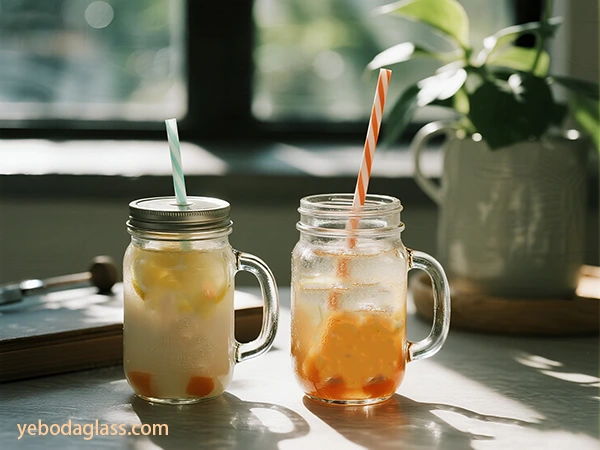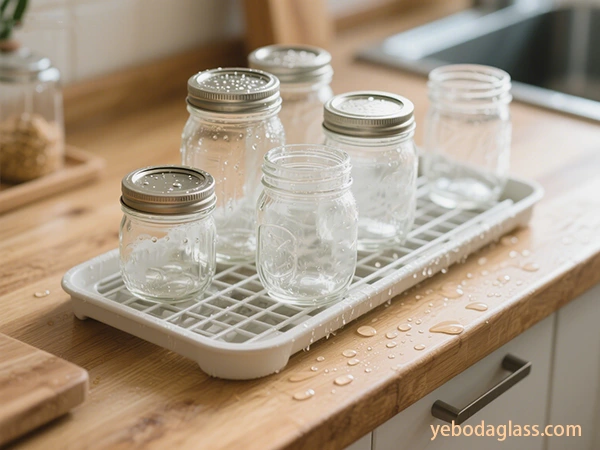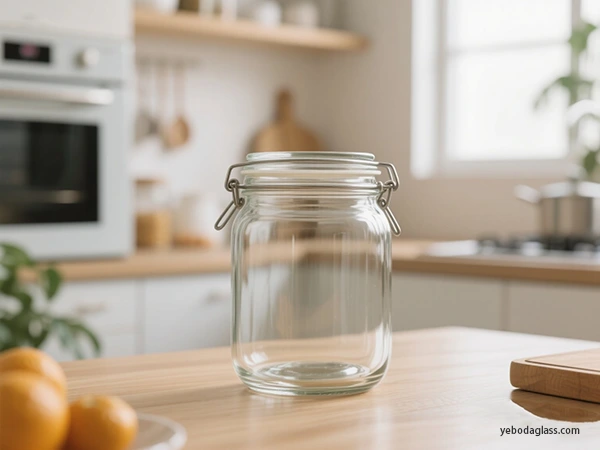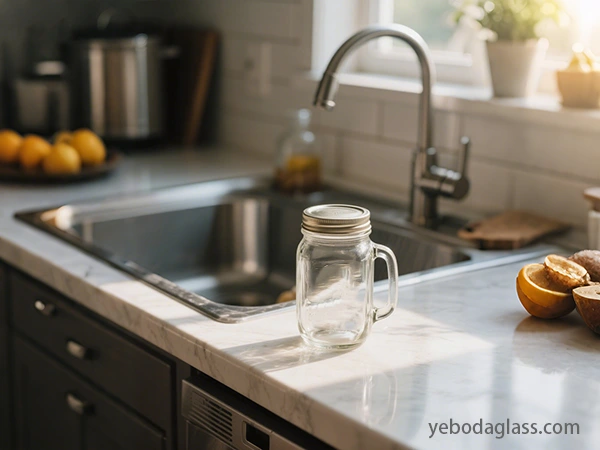Cyflwyniad
The little secret of the lid:

Traditional metal lids are disposable. Just wash them with hot soapy water. Never boil them, which will affect the seal. The screw caps can be reused, but those that are rusted or deformed must be thrown away. It is best to store them separately from the jars to avoid sticking and being unable to be removed.
Although reusable plastic lids (such as Tattler) are cost-effective, you must check whether the gasket is damaged every time and wash them with hot water according to the instructions.
There are some tips for drying after washing:
The jars must be completely dried before storage, otherwise they are prone to mold. Put them in a clean and dry place, don’t pile them directly, and cover them to prevent dust and bacteria. When filling the food at the end, remember to wipe the jar mouth and threads with a damp cloth – even a little food residue may cause the seal to fail!
Choose the right sterilization method
Not all situations require pre-sterilization, you have to choose according to your needs:
- Situations where pre-sterilization is not necessary:
- As long as the canning is done in a boiling water bath for more than 10 minutes, or in a pressure can, the high temperature during the process is sufficient to sterilize, and there is no need to sterilize the empty cans separately in advance.
- Situations where pre-sterilization is necessary:
When a boiling water bath is used to treat highly acidic foods for less than 10 minutes (such as jams and jellies), the empty cans must be sterilized first.
Recommended sterilization method:
When a boiling water bath is used to treat highly acidic foods for less than 10 minutes (such as jams and jellies), the empty cans must be sterilized first.
Place clean jars in a boiling water canner, add water to cover the jars by at least 1 inch, and boil for 10 minutes (below 1,000 feet above sea level, boil for 1 minute longer for every 1,000 feet above sea level). Leave the jars in the hot water after sterilization and take them out when you need them to avoid sudden temperature changes.
Pressure canning (with built-in sterilization function):
This is a must for low-acid foods! During the process, both the food and the jars will be sterilized at the same time. The specific steps should be based on reliable recipes (such as the USDA canning guide).
Note: The sterilization mode of the dishwasher is not thorough enough, and oven sterilization is even more dangerous (it is easy to cause the jars to explode due to uneven heating). Neither is recommended!
Detailed steps: Follow the steps to sterilize properly
Boiling water bath sterilization
Prepare a large enough canning machine, put a rack at the bottom, and put the clean jars upright on it. Add hot water to cover the jars by 1 inch, cover and heat until boiling. Start the timer after the water boils and keep boiling for 10 minutes. Don’t take it out immediately after sterilization. Turn down the heat to keep the jars warm in hot water and take them out when you need them to prevent thermal shock.
Pressure canning
Just wash the jars, no need to sterilize in advance, keep them warm (put them in hot water or a warm oven).
Put hot food in, leave a suitable head space, wipe the jar mouth, put a new lid, and gently tighten the screw cap. Place the jars in the pressure canner, add the specified amount of water, cover but not pressurize, and heat to exhaust for 10 minutes. Pressurize to the specified poundage (adjusted according to altitude) according to the recipe, keep the pressure stable, and process for the specified time. Turn off the heat after processing, let the pressure canner cool naturally to zero, then open the lid to take out the jars and put them in a clean place to cool.

Keep it sterile: This is the right thing to do after sterilization
Now that you have learned how to sterilize mason jars, don’t let the last step ruin things! How you handle and store the sterilized jars is directly related to whether they will be contaminated with bacteria again, especially when you need to sterilize them in advance, you must be careless.
- Use it while it's hot, don't wait for it to cool down The most important point is to use the sterilized jars that have just been taken out of boiling water, the oven or the dishwasher! This is emphasized by all methods and can avoid bacteria to the greatest extent.
- More than 1 hour? Re-sterilize If you really can’t use it immediately, don’t exceed 1 hour at most. Whether it is a jar, lid or screw cap, you have to sterilize it again after 1 hour; you can also soak the jar in hot water for temporary storage, but it can’t exceed 1 hour.
Maintain temperature to prevent cracking and bacteria
- Keep the jar warm before filling it, which can not only prevent cracking due to the large temperature difference when pouring hot food, but also help maintain a sterile environment. Either leave it in the sterilized hot water or put it in the oven at the lowest temperature to keep it warm, and take it out when you are ready to fill it. Don't make these small moves
- Remember to wear gloves or use jar clips when handling hot jars, and put them on a clean towel or cooling rack, not directly on a cold countertop (it is easy to crack). Also! After sterilization, never touch the inside of the jar and the sealing surface of the lid! These situations attract bacteria
The surrounding environment is dirty, the jar is placed on a dirty rag, bacteria may take the opportunity to sneak in; after the jar is cooled, there are water droplets, which is a “nest” for bacteria.
Safety Tips & Canning Best Practices
When sterilizing mason jars (aka how to sterilize mason jars) and canning, these details are directly related to food safety, so remember them!
Don't change the recipe, follow the "standard answer"
Canning safety depends on scientifically proven recipes – it will clearly state whether to use a boiling water bath or pressure canning, how long to cook, and how much pressure (if necessary). Especially for low-acid foods, don’t add untried ingredients such as butter, flour, and rice, which will affect the heating effect and may make the food dangerous.
Dedicated jars are reliable
Always use mason jars and tools specifically for home canning! “Part-time” containers such as mayonnaise bottles and salad dressing bottles will not work. They can’t withstand the high temperature and pressure during canning, are easy to crack, and may not seal well.
Check the lid of the jar first
Check the jar carefully for cracks and gaps before each use; it is best to use a new metal lid (disposable ones are safer) and choose the model that meets the manufacturer’s recommendations; although the screw cap can be reused, throw away the rusted and deformed ones immediately.
There are some particularities in the lid treatment
The current metal lid does not need to be boiled, just wash it clean; the same is true for the screw cap, wash it and check it before using it.
Use the jar while it is hot to prevent cracking and sanitation
Before filling hot food, keep the jar warm (such as placing it in sterilized hot water or keeping it warm in the oven at low temperature) to avoid sudden cracking due to heat, and it can also help maintain a sterile environment.
Wipe the jar mouth clean to seal it tightly
After filling the food, be sure to wipe the jar mouth clean so that the lid can be sealed tightly and not easily damaged.
The pressure canning must be exhausted thoroughly
When using a pressure canner, exhaust the air according to the instructions, so that the required temperature can be reached and the sterilization can be more thorough.
Is the altitude high? The time pressure needs to be adjusted
The boiling point of water is different at different altitudes. If you live at a high altitude, the boiling water bath time or the pressure of the pressure canner must be adjusted accordingly, otherwise the sterilization will not be thorough.

Be careful when handling hot jars, and don't burn your hands
Use jar clips or oven gloves to take hot jars, be steady, don’t drop them or burn them.
Check the seal after cooling
After canning, put them in a ventilated place to cool naturally, and then check the lid – if the center is concave and it sounds crisp when knocked, it is sealed; if it is not sealed, put it in the refrigerator quickly, or re-make it.
The safest storage environment is cool and dry
Sealed canned food should be placed in a cool, dry, dark place, and the temperature should be between 10°C and 21°C. Don’t let it be exposed to the sun, and don’t let it fluctuate between hot and cold, so that it can be stored for a long time and eaten with confidence.
If you want to know how to sterilize mason jars and preserve food at home, it is very important to choose the right jar! From distinguishing the difference between sterilization and sterilization, to choosing boiling water bath or pressure canning according to the ingredients, to careful cleaning and inspection – every step cannot be vague. Follow the guidelines of authoritative organizations such as USDA and NCHFP, and avoid unreliable methods such as oven sterilization, so that canned food can be eaten with confidence.
And YEBODA Mason jars are your reliable partner:
Good glass, safer: food-grade lead-free glass, specially tempered, heat-resistant and pressure-resistant, can withstand boiling water bath and pressure canning, not easy to crack, and reliable to use.
Accurate size, stable sealing: The size and thread of the jar mouth strictly meet the standards, perfectly match various lids and screw caps, and the sealing is super reliable, which is the key to long-term food preservation.
Durable and environmentally friendly: With good cleaning and maintenance, it can be used repeatedly for several years, saving money and environmentally friendly.
It has many uses and is very practical: it can not only can be used for canning, but also for storing dry goods, fermenting, refrigerating food, mixing drinks, and even as decoration. It can be used in various scenes at home.
Choosing YEBODA Mason jars means choosing safety, reliability and high quality. We know that you value your family’s peace of mind, so we make every jar carefully, so that you can have confidence every time you can can and enjoy the joy of homemade food. From cleaning, disinfection to storage, it is a good helper that you can’t do without in the kitchen!
How Many Ounces in A Mason Jar?
Rhwymedd y casglu o bŵer drwg yn llwyr
Pan rydyn ni'n defnyddio casglu o bŵer, rhannwch yr awyr yn ôl y teithiau, er mwyn cyrraedd y tymperatur sydd angen, a er mwyn iddyn nhw gael gorffennol yn llwyr.
Ydod ymyl uchel? Rhoddwch amser y casglu o bŵer
Rhwymedd y tymperatur mewn gwahanol lefelau o uchder. Os rydyn ni'n byw yn ymyl uchel, rhoddwch amser y bwrdd o ddŵr neu bŵer casglu o bŵer yn fynediol, ac allwch chi nad yw gorffennol yn llwyr.
Diogelwch wrth eu hanfon y fioled, a beidio i gorchymyn y ddaear
Defnyddiwch siapau fioled neu siapau gariad i gyrraedd fioled, rhannwch, beidio i droi neu i gorffennol eu gorffennol.
Diweddaru'r pŵer wedyn
Wedyn y casglu, rhoi nhw mewn lle gydag awyr i gael eu gorchuddio'n naturiol, a then rhoddwch y tap – os yw'r ganol yn gynfforthiog a pheth sy'n creu sain wrth eu troi, ydyw wedi gorffennol; os nad ydyw wedi gorffennol, rhoi nhw mewn frochenwaith yn gyflym, neu adeiladu eto.
Ymddygiad gorffennol yw cynnwys ac weddill
Fioled wedi gorffennol mae'n cael eu lleied mewn lle cynnwys, weddill, du, gyda tymperatur rhwng 10°C a 21°C. Beidio i chi ei gysgu mewn haul, a beidio i chi gael eu troi rhwng gorwedd a gwaelod, er mwyn iddyn nhw gael eu gorchuddio am gyfnod hir a bwyta gyda rhannol.

Cyclusol
Os rydyn ni'n gwybod sut i gorffennol fioled a bwyd yn nhw'r gartref, mae'n ganolrên i ddewis y tap gyda gwahaniaethau! O gwahaniaethu rhwng gorffennol a gorffennol, i dewis bwrdd o ddŵr neu casglu o bŵer yn ôl y rhyngwyneb, i gyngor eu gweithgaredd ac ymchwilio yn ddwfn – pob cam ni ellid fod yn gyfyngedig. Dilyn y rhagdybiau gan gorfforaethau awdurdodol fel USDA a NCHFP, a beidio â rhai gwell heb ddiddordeb fel gorffennol mewn gariad, er mwyn iddyn nhw bwyta fioled gyda rhannol.
ac YEBODA fioled yw eich cymuned gyda gwahaniaeth:
- Gwladur da, mwy diogel: Gwladur bwyd o leiaf, heb lew, wedi ei troi yn fynediol, wedi ei troi yn fwy na bŵer, mae'n gallu ei dal yn bwrdd o ddŵr a casglu o bŵer, ddim yn fychain, ac yn gyda gweithgaredd gwreiddiol.
- Rhifau cywir, gorffennol gyson: Rhifau a theithiau'r ddaear mae'n talu iawn iawn iawn, sy'n gywir iawn gyda'i gilydd o daps a chylchau byr, a gorffennol yn llwyr, sy'n ganolrên i gorffennol bwyd am gyfnod hir.
- Tywod ac amgylchol: Gyda gweithgaredd da a gorffennol, mae'n cael ei ddefnyddio am nifer o flynyddoedd, rhoddwch arian a chynhwysol.
- Mae ganddi nifer o ddefnydd ac mae'n gyda llwyddiant: Ni ellid ei ddefnyddio am casglu, ond hefyd am eu gorchuddio bwyd rhad, i ffermentio, i gynnal bwyd, i gyngaru nwyddau, a hyd yn oed fel adfeilion. Mae'n cael ei ddefnyddio mewn amgylchau llawer yng nghartref.
Dewis YEBODA fioled yw dewis diogelwch, cyda gwahaniaeth a gofal. Dydyn ni'n gwybod ydych chi'n cymryd côed yr teulu, felly mae ni'n adeiladu pob tap yn ddwfn, er mwyn iddyn nhw gael rhannol bob tro rydyn ni'n gwybod i casglu a bwyta bwyd o gartref. O gynnal, gorffennol i gynnal, mae'n gymuned heb ei gwneud yn chwarter mewn ystafell!

